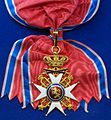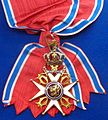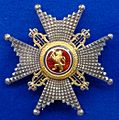
The Order of the Falcon is the only order of chivalry in Iceland, founded by King Christian X of Denmark and Iceland on 3 July 1921. The award is awarded for merit for Iceland and humanity and has five degrees. Nowadays, appointments are made on the nomination of the President of Iceland and that of a "five-member council."

The Order of the Dannebrog is a Danish order of chivalry instituted in 1671 by Christian V. Until 1808, membership in the Order was limited to fifty members of noble or royal rank, who formed a single class known as White Knights to distinguish them from the Blue Knights who were members of the Order of the Elephant. In 1808, the Order was reformed and divided into four classes. The statute of the Order was amended in 1951 by a Royal Ordinance so that both men and women could be members of the Order. Today, the Order of the Dannebrog is a means of honouring and rewarding the faithful servants of the modern Danish state for meritorious civil or military service, for a particular contribution to the arts, sciences or business life, or for working for Danish interests.

The Order of Leopold is one of the three current Belgian national honorary orders of knighthood. It is the oldest and highest order of Belgium and is named in honour of its founder, King Leopold I. It consists of a military, a maritime and a civil division. The maritime division is only awarded to personnel of the merchant navy, and the military division to military personnel. The decoration was established on 11 July 1832 and is awarded by Royal decree.
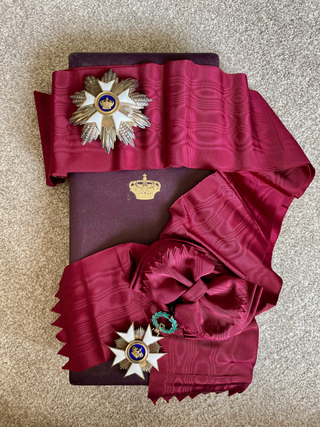
The Order of the Crown is a national order of the Kingdom of Belgium. The Order is one of Belgium's highest honors.

The Order of Orange-Nassau is a civil and military Dutch order of chivalry founded on 4 April 1892 by the queen regent, Emma of the Netherlands.

The Order of Polonia Restituta is a Polish state order established 4 February 1921. It is conferred on both military and civilians as well as on foreigners for outstanding achievements in the fields of education, science, sport, culture, art, economics, national defense, social work, civil service, or for furthering good relations between countries. It is Poland's second-highest civilian state award in the order of precedence, behind the Order of the White Eagle.
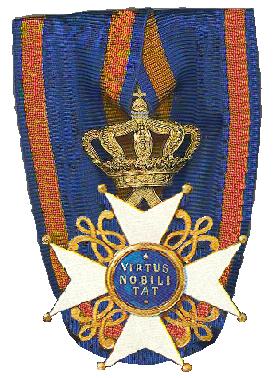
The Order of the Lion of the Netherlands, also known as the Order of the Netherlands Lion is a Dutch order of chivalry founded by King Willem I of the Netherlands on 29 September 1815.

The Order of the Oak Crown is an order of the Grand Duchy of Luxembourg.

The Royal Order of the Sword is a Swedish order of chivalry and military decoration created by King Frederick I of Sweden on 23 February 1748, together with the Order of the Seraphim and the Order of the Polar Star. The motto of the order is in Latin: Pro Patria.

The Order of Civil and Military Merit of Adolph of Nassau is an order of merit of the Grand Duchy of Luxembourg for meritorious service to the Grand Duke, the Grand-Ducal House and Luxembourg. It was founded in 1858 as a chivalric order of the Duchy of Nassau by Adolphe of Nassau in honor of his namesake and ancestor, Adolf, Count of Nassau, the only member of the House of Nassau to have been Roman King of Germany. After the Duchy of Nassau was annexed by Prussia in 1866 and Adolphe became Grand Duke of Luxembourg in 1890, he revived the order as an order of merit.

The Royal Order of the Seraphim is a Swedish order of chivalry created by King Frederick I on 23 February 1748, together with the Order of the Sword and the Order of the Polar Star. The order has only one class with the dignity of Knight, and is the foremost order of Sweden.

The Royal Order of George I is a Greek order instituted by King Constantine I in 1915. Since the monarchy's abolition in 1973, it has been considered a dynastic order of the former Greek royal family.

The Royal Order of Vasa is a Swedish order of chivalry founded on 29 May 1772 by King Gustav III. It is awarded to Swedish citizens for service to state and society especially in the fields of agriculture, mining and commerce.

The Royal Order of the Polar Star, sometimes translated as the Royal Order of the North Star, is a Swedish order of chivalry created by King Frederick I on 23 February 1748, together with the Order of the Sword and the Order of the Seraphim. The Order of the Polar Star is intended as a reward for Swedish and foreign "civic merits, for devotion to duty, for science, literary, learned and useful works and for new and beneficial institutions".
The Order of Grimaldi is an Order established in Monaco on 18 November 1954.
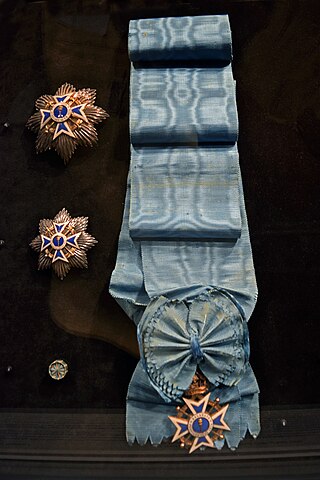
The Royal Order of Kalākaua I was instituted on 28 September 1874 by King Kalākaua I to commemorate his accession to the throne of the Kingdom of Hawaiʻi on 12 February 1874.
The Order of the African Star was established by Leopold II of Belgium on 30 December 1888, in his capacity as ruler of the Congo Free State, and was awarded for services to Congo and for the "promotion of African civilisation in general". It was incorporated into the Belgian honours system on 10 October 1908 following the annexation of the Congo Free State by Belgium. The motto of the Order is "Travail et progrès". The King of the Belgians is its Grand Master; although the Congo is no longer a Belgian colony, it is still considered to be a Belgian Order by tradition.

The Royal Order of the Lion was established by King Leopold II of Belgium on 9 April 1891, in his capacity as ruler of the Congo Free State, and was awarded for services to the Congo and its ruler that did not deserve the award of the Order of the African Star, and were not necessarily performed from within Belgian Congo.
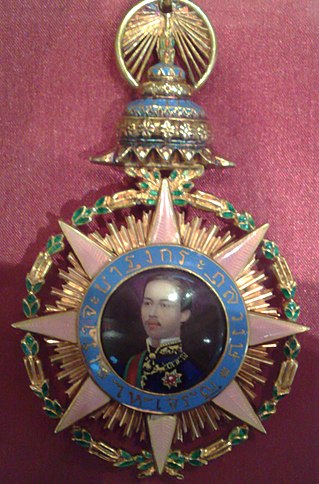
The Most Illustrious Order of Chula Chom Klao was established on 16 November 1873 by King Rama V of The Kingdom of Siam to commemorate the 90th Jubilee of the Chakri Dynasty and bears his name. The pink colour reflects the Tuesday birthday colour for King Rama V.
The Order of Civil Merit was an Order of Merit of the Kingdom of Bulgaria. Established in 1891, it had six classes.



